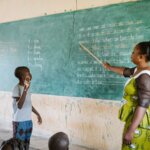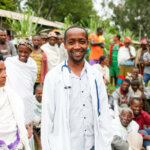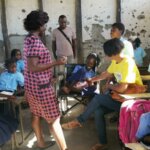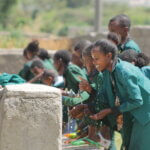- Inclusive Education
It’s the world’s most comprehensive analysis of inclusion and education, and it’s out now. The 2020 global education monitoring report All Means All spotlights the needs of children with disabilities, thanks to the commitment of many advocates including Nafisa Baboo, Director on Inclusive Education at Light for the World. She tells us why we should all be paying it close attention.
Governments across the world promised to deliver inclusive education for all by 2030. With just a decade to go until that deadline, it’s vital that we focus now on those who are truly left behind.
The global education monitoring (GEM) report, All Means All, focuses on the most marginalised: children with disabilities, linguistic minorities and Indigenous people. It’s particularly apt at this time, because if we want to fast-track progress towards this goal, we’ll need to ensure that education systems really do support all children.
The good news is we’ve made some progress. The report tells us that 15% of out of school children are children with disabilities. This is actually quite promising in those countries where these surveys were conducted. But the reality is that children with disabilities experience insurmountable challenges staying in school and progress through education, with only 85% of children with disabilities in school. Those with a sensory, physical or intellectual disability are 2.5 times more likely to have never been in school as their peers without disabilities.
The greatest progress has been in terms of policies and legislation around inclusion. Some 67% of countries have policies on including learners with disabilities. That’s really promising, but there’s a gap between policy and implementation.
Barriers to inclusion
There isn’t one big barrier to inclusive education. We need to look at the whole system: the community, government. The truth is, different government departments are not necessarily working together in a coordinated way.
Just as exclusion is multi-dimensional, the solutions for promoting inclusive education systems are also multi-faceted. You need to take a multi-pronged approach, understanding that it’s more a process than a goal.
COVID-19 lays challenges bare
The COVID-19 pandemic and distance learning mode that many countries have had to switch to has really exacerbated and made more evident the disparities that currently exist between those who have and those who have not, and those with disabilities and those without.
The report says that 55% of low-income countries switched to online distance learning in primary and secondary education. Yet only 12% of households in the least developed countries have internet access at home. Nearly half of low and middle-income countries have not supported learners at risk of exclusion.
This really elevates the serious impact that the school closures have had on children with disabilities and also parents. Because they don’t have the technology to support their learning, they’ve been severely disadvantaged. We know that children with disabilities and girls who are most marginalised are at high risk of not returning to school. So, we really need to up our game to ensure that they do.
Not just white canes and wheelchairs
How do we up our game? By encouraging greater investment in ensuring that children with disabilities have access to the right technology to promote their learning.
Before, people only thought about white canes and wheelchairs, but we need to look at technology like tablets and mobile phones, and be creative on how we reach young children in particular.
Because of the emphasis on numeracy and literacy, there’s been a lack of work in the education system to promote resilience and socio-emotional learning. This is highlighted even more now with the pandemic. We need to take a holistic approach to developing children’s skills when we re-build once the pandemic is over.
Targeted finance
For me, the fundamental step is to target finance at those left behind. As the report says, there’s no inclusion when millions lack access to education.
Governments need to target funding at those furthest behind as early as possible. This would help them access schools and also early interventions. It would reduce the potential impact of a disability, and ensure progress and learning later on. This will allow us to improve education systems overall.
Donors need to make sure that all education programmes are disability inclusive and boost their investment in projects and innovation. This should be backed with research so we have evidence of what works and what doesn’t.
A lifelong passion
Inclusive education for children with disabilities is my passion. I was part of the advisory team for All Means All and for the advocacy steering group for the report. To see this report breaking through onto the education agenda makes me super proud. I hope it will catalyse rapid change and encourage governments to do more.



